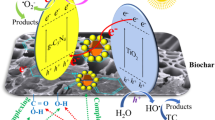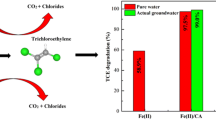Abstract
The combination of zerovalent iron (Fe0) and titanium dioxide (TiO2) has been investigated as a promising method for environmental remediation. However, it is a challenge to prepare conveniently desirable Fe0/TiO2 nanocomposites with excellent efficiency and reusability. Here, a novel nanocomposite material, Fe0/TiO2@D201, was synthesized to enhance the removal of Cr(VI) from an aqueous system by impregnating Fe0 and TiO2 inside a commercial anion exchanger (D201). The proposed structure and Cr(VI) removal mechanism of Fe0/TiO2@D201 were confirmed using scanning electron microscopy (SEM), transmission electron microscopy (TEM), X-ray diffraction (XRD), and X-ray photoelectron spectroscopy (XPS) analysis. Compared to the monometallic samples (Fe0-D201 and TiO2-D201), Fe0/TiO2@D201 showed outstanding Cr(VI) removal and the removal ratio reached up to 97.30% after 120 min of UV light irradiation. The removal of Cr(VI) by Fe0/TiO2@D201 remained high (91.70%) even after four cycles, indicating the stability of the nanocomposites toward Cr(VI) removal and their strong potential for practical applications. The addition of ethylenediaminetetraacetic acid (EDTA) positively affected the Cr(VI) reduction process, whereas the addition of Na2S2O8 negatively affected the Cr(VI) process. The XPS results revealed that the photocatalytic reduction of Cr(VI) by Fe0/TiO2@D201 involved the capture of photoexcited electrons and Fe0 reduction. A path for the photogenerated electrons engaging in the reduction reaction to improve the utilization of Fe0 was proposed. These results demonstrate that Fe0/TiO2@D201 is a promising alternative composite catalyst for the efficient Cr(VI) removal from contaminated water.









Similar content being viewed by others
Data availability
The datasets used for this work are contained in the manuscript.
References
Chen L, ** S, Fallgren PH, Swoboda-Colberg NG, Liu F, Colberg PJ (2012) Electrochemical depassivation of zero-valent iron for trichloroethene reduction. J Hazard Mater 239–240:265–269. https://doi.org/10.1016/j.jhazmat.2012.08.074
Diao ZH, Xu XR, Jiang D, Kong LJ, Sun YX, Hu YX, Hao QW, Chen H (2016) Bentonite-supported nanoscale zero-valent iron/persulfate system for the simultaneous removal of Cr(VI) and phenol from aqueous solutions. Chem Eng J 302:213–222. https://doi.org/10.1016/j.cej.2016.05.062
Diao ZH, Xu XR, Jiang D, Liu JJ, Kong LJ, Li G, Zuo LZ, Wu QH (2017) Simultaneous photocatalytic Cr(VI) reduction and ciprofloxacin oxidation over TiO2/Fe0 composite under aerobic conditions: performance, durability, pathway and mechanism. Chem Eng J 315:167–176. https://doi.org/10.1016/j.cej.2017.01.006
Diao ZH, ** JC, Zou MY, Liu H, Qin JQ, Zhou XH, Qian W, Guo PR, Kong LJ, Chu W (2021) Simultaneous degradation of amoxicillin and norfloxacin by TiO2@nZVI composites coupling with persulfate: synergistic effect, products and mechanism. Sep Purif Technol 278:119620. https://doi.org/10.1016/j.seppur.2021.119620
Du J, Guo W, Che D, Ren N (2018) Weak magnetic field for enhanced oxidation of sulfamethoxazole by Fe0/H2O2 and Fe0/persulfate: performance, mechanisms, and degradation pathways. Chem Eng J 351:532–539. https://doi.org/10.1016/j.cej.2018.06.094
Du Y, Qiu S, Zhang X, Nie G (2020) Nanoconfined hydrous titanium oxides with excellent acid stability for selective and efficient removal of As(V) from acidic wastewater. Chem Eng J 400:125907. https://doi.org/10.1016/j.cej.2020.125907
Fan D, Lan Y, Tratnyek PG, Johnson RL, Filip J, O’Carroll DM, Nunez Garcia A, Agrawal A (2017) Sulfidation of iron-based materials: a review of processes and implications for water treatment and remediation. Environ Sci Technol 51:13070–13085. https://doi.org/10.1021/acs.est.7b04177
Guan X, Sun Y, Qin H, Li J, Lo IM, He D, Dong H (2015) The limitations of applying zero-valent iron technology in contaminants sequestration and the corresponding countermeasures: the development in zero-valent iron technology in the last two decades (1994–2014). Water Res 75:224–248. https://doi.org/10.1016/j.watres.2015.02.034
Hatefirad P, Hosseini M, Tavasoli A (2022) Effect of Fe/Cu catalysts supported on zeolite/active carbon hybrid on bio-oil quality derived from catalytic pyrolysis of granular bacteria biomass. Fuel 312:122870. https://doi.org/10.1016/j.fuel.2021.122870
Hua Z, Dai Z, Bai X, Pan W, Zhang X, Ma W, Huang X, Gu L (2014) Zero-valent nanophase iron and nitrogen co-modified titania nanotube arrays: synthesis, characterization, and enhanced visible-light photocatalytic performance. Mater Sci Semicond Process 26:410–418. https://doi.org/10.1016/j.mssp.2014.05.029
Huang C, Hsieh W, Pan J, Chang S (2007) Characteristic of an innovative TiO2/Fe0 composite for treatment of azo dye. Sep Purif Technol 58. https://doi.org/10.1016/152-15810.1016/j.seppur.2007.07.034
Imran M, Saeed Z, Pervaiz M, Mehmood K, Ejaz R, Younas U, Nadeem HA, Hussain S (2021) Enhanced visible light photocatalytic activity of TiO2 co-doped with Fe Co, and S for degradation of Cango red. Spectrochim Acta A Mol Biomol Spectrosc 255:119644. https://doi.org/10.1016/j.saa.2021.119644
Lace A, Ryan D, Bowkett M, Cleary J (2019) Chromium monitoring in water by colorimetry using optimised 1,5-diphenylcarbazide method. Int J Environ Res Public Health 16:1803. https://doi.org/10.3390/ijerph16101803
Lin H, Huang C, Li W, Ni C, Shah S, Tseng Y (2006) Size dependency of nanocrystalline TiO2 on its optical property and photocatalytic reactivity exemplified by 2-chlorophenol. Appl Catal B 68:1–11. https://doi.org/10.1016/j.apcatb.2006.07.018
Liu H, Li G, Qu J, Liu H (2007) Degradation of azo dye acid orange 7 in water by Fe0/granular activated carbon system in the presence of ultrasound. J Hazard Mater 144:180–186. https://doi.org/10.1016/j.jhazmat.2006.10.009
Liu T, Li X, Waite TD (2013) Depassivation of aged Fe0 by inorganic salts: implications to contaminant degradation in seawater. Environ Sci Technol 47:7350–7356. https://doi.org/10.1021/es400362w
Lu J, Liu D, Hao J, Zhang G, Lu B (2015) Phosphate removal from aqueous solutions by a nano-structured Fe–Ti bimetal oxide sorbent. Chem Eng Res Des 93:652–661. https://doi.org/10.1016/j.cherd.2014.05.001
Madan S, Shaw R, Tiwari S, Tiwari SK (2020) Enhancing corrosion stability and shelf life of nanoscale zero-valent iron via encapsulation in porous Ze-TiO2 matrix: an interface for simultaneous oxidation and adsorption of As(III). Colloids Surf, A 607:125381. https://doi.org/10.1016/j.colsurfa.2020.125381
Nie G, Wu L, Du Y, Wang H, Xu Y, Ding Z, Liu Z (2019) Efficient removal of phosphate by a millimeter-sized nanocomposite of titanium oxides encapsulated in positively charged polymer. Chem Eng J 360:1128–1136. https://doi.org/10.1016/j.cej.2018.10.184
Petala E, Baikousi M, Karakassides MA, Zoppellaro G, Filip J, Tucek J, Vasilopoulos KC, Pechousek J, Zboril R (2016) Synthesis, physical properties and application of the zero-valent iron/titanium dioxide heterocomposite having high activity for the sustainable photocatalytic removal of hexavalent chromium in water. Phys Chem Chem Phys 18:10637–10646. https://doi.org/10.1039/c6cp01013j
Raez JM, Arencibia A, Segura Y, Arsuaga JM, López-Muñoz MJ (2021) Combination of immobilized TiO2 and zero valent iron for efficient arsenic removal in aqueous solutions. Sep Purif Technol 258:118016. https://doi.org/10.1016/j.seppur.2020.118016
Rashtbari Y, Américo-Pinheiro JHP, Bahrami S, Fazlzadeh M, Arfaeinia H, Poureshgh Y (2020) Efficiency of Zeolite coated with zero-valent iron nanoparticles for removal of humic acid from aqueous solutions. Water Air Soil Pollut 231:514. https://doi.org/10.1007/s11270-020-04872-9
Saeed K, Khan I, Gul T, Sadiq M (2017) Efficient photodegradation of methyl violet dye using TiO2/Pt and TiO2/Pd photocatalysts. Appl Water Sci 7:3841–3848. https://doi.org/10.1007/s13201-017-0535-3
Singh J, Juneja S, Soni RK, Bhattacharya J (2021) Sunlight mediated enhanced photocatalytic activity of TiO2 nanoparticles functionalized CuO-Cu2O nanorods for removal of methylene blue and oxytetracycline hydrochloride. J Colloid Interface Sci 590:60–71. https://doi.org/10.1016/j.jcis.2021.01.022
Song Y, Li Z, Shao S, Jiao W, Liu Y (2021a) High-gravity intensified preparation of D201 resin-hydrated iron oxide nanocomposites for Cr(VI) removal. Adv Powder Technol 32:1584–1593. https://doi.org/10.1016/j.apt.2021.03.012
Song Y, Zeng Y, Liao J, Chen J, Du Q (2021b) Efficient removal of sulfamethoxazole by resin-supported zero-valent iron composites with tunable structure: performance, mechanisms, and degradation pathways. Chemosphere 269:128684. https://doi.org/10.1016/j.chemosphere.2020.128684
Tanboonchuy V, Hsu JC, Grisdanurak N, Liao CH (2011) Gas-bubbled nano zero-valent iron process for high concentration arsenate removal. J Hazard Mater 186:2123–2128. https://doi.org/10.1016/j.jhazmat.2010.12.125
Tosco T, Petrangeli Papini M, Cruz Viggi C, Sethi R (2014) Nanoscale zerovalent iron particles for groundwater remediation: a review. J Clean Prod 77:10–21. https://doi.org/10.1016/j.jclepro.2013.12.026
Yuan B, Qian Z, Yu Q, Hao R, Zhao Y (2021) Ultraviolet-induced nitric oxide removal using H2O/O2 catalyzed by Fe/TiO2: Feasibility and prospect. Fuel 290:120026. https://doi.org/10.1016/j.fuel.2020.120026
Zafar Z, Fatima R, Kim JO (2021) Experimental studies on water matrix and influence of textile effluents on photocatalytic degradation of organic wastewater using Fe-TiO2 nanotubes: towards commercial application. Environ Res 197:111120. https://doi.org/10.1016/j.envres.2021.111120
Zhang G, Liu Y, Hashisho Z, Sun Z, Zheng S, Zhong L (2020) Adsorption and photocatalytic degradation performances of TiO2/diatomite composite for volatile organic compounds: effects of key parameters. Appl Surf Sci 525:146633. https://doi.org/10.1016/j.apsusc.2020.146633
Zhu F, Li L, Ma S, Shang Z (2016) Effect factors, kinetics and thermodynamics of remediation in the chromium contaminated soils by nanoscale zero valent Fe/Cu bimetallic particles. Chem Eng J 302:663–669. https://doi.org/10.1016/j.cej.2016.05.072
Funding
We greatly acknowledge the support from the National Natural Science Foundation of China (No. 21707166), State Key Laboratory of Pollution Control and Resource Reuse Foundation, (No. PCRRF22012), Jiangsu Key Laboratory of Atmospheric Environment Monitoring and Pollution Control Foundation (No. KHK1905), and the National Innovation and Entrepreneurship Training Program for Undergraduate (No. 2023103161359).
Author information
Authors and Affiliations
Contributions
All authors contributed to the study conception and design. Material preparation, data collection, and analysis were performed by Ting Jiang, Jian Chai, and Yingying Wang. Conceptualization, ideas, formal analysis, resources, supervision, and funding acquisition by Qiong Du, **g Shi, and Zhengwen Xu. The first draft of the manuscript was written by Ting Jiang and all authors commented on previous versions of the manuscript. All authors read and approved the final manuscript.
Corresponding author
Ethics declarations
Ethical approval
Not applicable.
Consent to participate
Not applicable.
Consent for publication
Not applicable.
Competing interests
The authors declare no competing interests.
Additional information
Responsible Editor: George Z. Kyzas
Publisher's Note
Springer Nature remains neutral with regard to jurisdictional claims in published maps and institutional affiliations.
Supplementary Information
Below is the link to the electronic supplementary material.
Rights and permissions
Springer Nature or its licensor (e.g. a society or other partner) holds exclusive rights to this article under a publishing agreement with the author(s) or other rightsholder(s); author self-archiving of the accepted manuscript version of this article is solely governed by the terms of such publishing agreement and applicable law.
About this article
Cite this article
Jiang, T., Chai, J., Wang, Y. et al. Enhanced photocatalytic reduction of Cr(VI) from aqueous solution using Fe0/TiO2-based polymeric nanocomposites. Environ Sci Pollut Res 30, 110312–110323 (2023). https://doi.org/10.1007/s11356-023-30106-6
Received:
Accepted:
Published:
Issue Date:
DOI: https://doi.org/10.1007/s11356-023-30106-6




